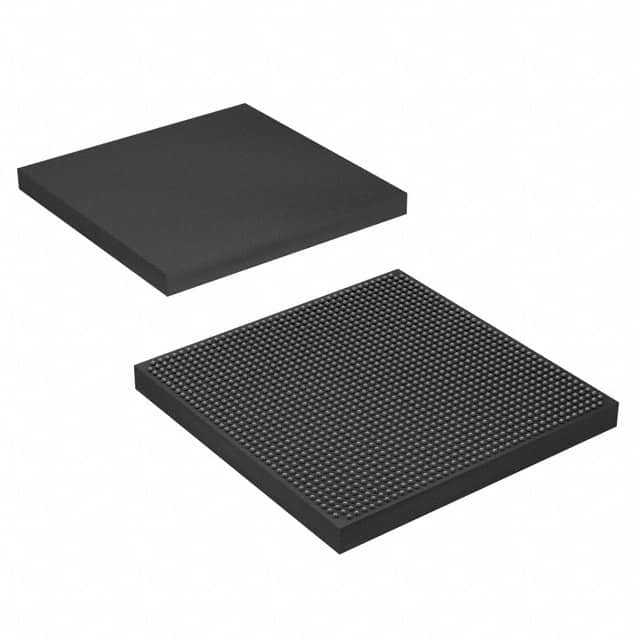5SGXEB6R2F40I2N
Product Overview
Category
The 5SGXEB6R2F40I2N belongs to the category of Field-Programmable Gate Arrays (FPGAs).
Use
FPGAs are integrated circuits that can be programmed and reprogrammed to perform various digital functions. The 5SGXEB6R2F40I2N is specifically designed for high-performance applications.
Characteristics
- High-performance FPGA with advanced features
- Large capacity and high-speed processing capabilities
- Flexible and customizable design options
- Low power consumption
- Robust and reliable performance
Package
The 5SGXEB6R2F40I2N comes in a compact and durable package, ensuring easy handling and protection during transportation and installation.
Essence
The essence of the 5SGXEB6R2F40I2N lies in its ability to provide a versatile and powerful platform for implementing complex digital systems.
Packaging/Quantity
The 5SGXEB6R2F40I2N is typically packaged individually and is available in various quantities depending on the customer's requirements.
Specifications
- FPGA Family: Stratix V
- Logic Elements: 622,080
- Embedded Memory: 34,816 Kbits
- DSP Blocks: 1,288
- Maximum User I/Os: 1,280
- Operating Voltage: 1.0V
- Operating Temperature Range: -40°C to +100°C
- Package Type: F40
- Package Pins: 1517
Detailed Pin Configuration
For a detailed pin configuration diagram of the 5SGXEB6R2F40I2N, please refer to the manufacturer's datasheet or documentation.
Functional Features
- High-speed data processing capabilities
- Support for various communication protocols
- On-chip memory resources for efficient data storage
- Flexible I/O options for interfacing with external devices
- Built-in security features for protecting sensitive information
Advantages and Disadvantages
Advantages
- High-performance computing capabilities
- Flexibility in design and customization
- Low power consumption compared to traditional ASICs
- Faster time-to-market due to reprogrammability
- Cost-effective solution for prototyping and low-volume production
Disadvantages
- Higher cost compared to general-purpose microcontrollers
- Steeper learning curve for programming and utilizing FPGA technology
- Limited availability of specialized technical support
Working Principles
The 5SGXEB6R2F40I2N operates based on the principles of digital logic. It consists of a large number of configurable logic blocks interconnected through programmable routing resources. The user can program the FPGA to implement desired logic functions by configuring the interconnections and functionality of these blocks.
Detailed Application Field Plans
The 5SGXEB6R2F40I2N finds applications in various fields, including but not limited to: - Telecommunications - Data centers - Aerospace and defense - Industrial automation - Medical equipment - Automotive electronics
Detailed and Complete Alternative Models
- 5SGXEB6R2F40C2N
- 5SGXEB6R2F40I3N
- 5SGXEB6R2F40C3N
- 5SGXEB6R2F40I4N
- 5SGXEB6R2F40C4N
These alternative models offer similar features and performance characteristics as the 5SGXEB6R2F40I2N, but may differ in terms of package type, pin count, or additional functionalities.
Note: The above information is based on the available data at the time of writing and may be subject to change. For the most accurate and up-to-date information, please refer to the manufacturer's documentation.
Senaraikan 10 soalan dan jawapan biasa yang berkaitan dengan aplikasi 5SGXEB6R2F40I2N dalam penyelesaian teknikal
Sure! Here are 10 common questions and answers related to the application of 5SGXEB6R2F40I2N in technical solutions:
Q: What is the 5SGXEB6R2F40I2N FPGA used for? A: The 5SGXEB6R2F40I2N is a Field-Programmable Gate Array (FPGA) that can be used for various applications such as high-performance computing, networking, and signal processing.
Q: What are the key features of the 5SGXEB6R2F40I2N FPGA? A: Some key features include a large number of logic elements, high-speed transceivers, embedded memory blocks, and support for various communication protocols.
Q: Can the 5SGXEB6R2F40I2N FPGA be reprogrammed? A: Yes, FPGAs are designed to be reprogrammable, allowing users to modify the functionality of the device even after it has been deployed.
Q: How can the 5SGXEB6R2F40I2N FPGA be programmed? A: The 5SGXEB6R2F40I2N FPGA can be programmed using hardware description languages (HDLs) such as VHDL or Verilog, or through graphical programming tools provided by the FPGA manufacturer.
Q: What are some typical applications of the 5SGXEB6R2F40I2N FPGA? A: This FPGA can be used in applications like high-frequency trading, video processing, wireless communication systems, radar systems, and data center acceleration.
Q: Does the 5SGXEB6R2F40I2N FPGA support high-speed serial communication? A: Yes, the 5SGXEB6R2F40I2N FPGA has built-in high-speed transceivers that support protocols like PCIe, Ethernet, and Serial RapidIO.
Q: Can the 5SGXEB6R2F40I2N FPGA interface with external memory devices? A: Yes, this FPGA has embedded memory blocks and can also interface with external memory devices such as DDR3 or DDR4 SDRAM.
Q: What is the power consumption of the 5SGXEB6R2F40I2N FPGA? A: The power consumption of an FPGA depends on the design and usage. It is recommended to refer to the device datasheet for specific power consumption details.
Q: Are there any development boards available for the 5SGXEB6R2F40I2N FPGA? A: Yes, the FPGA manufacturer provides development boards that allow users to prototype and test their designs using the 5SGXEB6R2F40I2N FPGA.
Q: Can the 5SGXEB6R2F40I2N FPGA be used in safety-critical applications? A: FPGAs can be used in safety-critical applications, but additional measures need to be taken to ensure functional safety, such as redundancy, fault tolerance, and rigorous testing.
Please note that the answers provided here are general and may vary depending on the specific requirements and use cases of the application.


